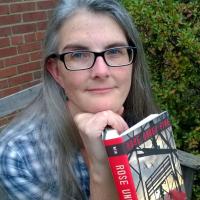Thanks to Twitter, last month I noticed that some of my teacher friends were producing and sharing a lot of great writing. They’d joined the Slice of Life Story Challenge hosted by Two Writing Teachers and were posting interesting writing about everyday experiences.
I so enjoyed getting glimpses of their writing lives, I reached out to see if they would share more about why they write, how it influences their instruction, and what kind of good things can happen when teachers write. Happily, Cindy Chiu, Sally Donnelly, and Beth Sanderson agreed to answer three questions about their writing which I’ll share in a series of posts here at Book Life.

Cindy Chiu is a Reading Specialist and the ELA lead teacher at Swanson Middle School in Arlington, Virginia. While she was teaching English overseas in Hong Kong and Beijing before applying to law school, a Chinese fortune teller told her she would become an educator instead. Over 15 years in elementary and middle school settings later, Ms. Chiu is still teaching and loving it. She describes herself as a teacher-reader-writer-mom who cannot live without books, tennis, and coffee.

Sally Donnelly is a National Board Certified Teacher in Literacy and an avid reader of children’s literature. She taught elementary school for 25 years in Diocese of Arlington, Fairfax County Public Schools, and Arlington Public Schools. Currently a 6th grade Reading teacher at Swanson Middle School in Arlington, Virginia, she’s also a regular learner at Teachers College Reading and Writing Project .

Beth Sanderson is an English teacher and instructional leader at Swanson Middle School in Arlington, Virginia. In over a decade of work in Virginia schools, Ms. Sanderson has designed reading intervention programs, taught reading and English in the classroom and taken a leadership role in professional learning initiatives. Her classroom has been featured in The Washington Post Magazine , NEA Today and the Book Club for Kids podcast . Prior to her work in education, Ms. Sanderson was vice president of a Washington, D.C. public affairs firm helping clients craft effective communication programs.
Question 1: Why and how should teachers be writers? What good things can happen when teachers write?
Cindy Chiu
When first given this prompt, I spun a web of tangled thoughts, finding myself stuck in my own written chaos. I consulted mentor texts, which seemed so succinct and clear, logical and organized. Why couldn’t I come up with a two-pronged thesis with specific examples? The more I tried to breathe in inspiration from others’ stories, the more I vomited a sticky mess on my own page. Prompts are usually road maps that guide me, but this one left me circling in self-doubt, worrying about being misunderstood because the words did not match my thoughts. In reality, my thoughts were not yet solidified, the destination undetermined.
Two days and twelve hours of obsessing over my impending deadline later, I finally realized that THIS is exactly WHY teachers should write. If an educator with two degrees and fifteen years on the job, who specializes in teaching language and literacy, is experiencing roadblocks in writing, how are our students — without even a driver’s permit — faring on these windy trails? Blank pages can invite or intimidate without discrimination.
The objective of our ELA department meeting this month was to teach by example. When teachers read and write alongside students, we can learn from each other how to weave a clumsy brainstorm into a polished piece by trusting the process and using revision strategies. We develop critical connections to students when we can empathize with them. So why do I write? I write to teach, process, learn, and discover. I write because I have a voice to share. I write to connect my past, present, and future. I write to exercise expressive language skills, keeping my writing brain well lubricated to convey thoughts in a comprehensible manner. I write to discover the poet and novelist hiding inside me all these years. I write to surprise my innermost critic. I write to chronicle my journey in finding my niche in this world, and in doing so, I am home.
Sally Donnelly
As I ponder my answer, two things come to mind. I write to help my students and I write to help myself.
I started writing and learning how to write better, so I could teach my students. I firmly believe I have to do what I ask my students to do. So I write. I struggle through staring at a blank page or screen thinking What to write? It helps me to name what helps me personally to get words on the page. Then I can honestly share tips with my student writers. My go-to tips include: think of an emotion and a moment related to that emotion or think of a person, place, or object and then a related special or ordinary moment. Then just write the moment. Or just write “I do not know what to write and then pushing the pencil or keys and realize after 15 minutes that the page/screen is filled. When my students have a research project, I struggle through a research project, too. I jot notes and then feel mad when I forget to jot down my source so when I thought I was done, I still have to spend another hour retracing my steps and completing my bibliography. Now I have my true research writing story to tell instead of only announcing to my students, “Be sure to include a bibliography”.
I started writing as a way to teach my students. Now I find myself writing for me. I find it relaxing to sit in a coffee shop and write. I like reflecting back on the day or week and seeing where my writing will take me. Often it is good therapy for me. I’ll jot down what feels like venting and somehow, the words help my thoughts to process and my venting turns into a solution. I may have started writing in a certain mood but I usually end, close my notebook or computer screen, feeling peaceful. So of course, I write!
Beth Sanderson
As I sit staring at a blank screen and a flashing cursor, I am struck with a cold realization … this is what writing feels like for many of my students.
The English teachers I know love to plan strong, authentic writing experiences for students. We work hard to identify mentor texts, build scaffolds and conference with students.
However, when I am not writing myself, I lose some of the empathy that exists among fellow writers.
- What is hard about the particular project?
- Where do I need more support?
- Would it help to talk to another writer about the sticking points?
I believe I am a better teacher when I write alongside my students.
The wise and wonderful Penny Kittle wrote, ““What power–what importance–lies in the blank lines of an open notebook. Go and fill yours. Then share.”
Time to start filling my blank pages.
About the Author
Join children’s literacy consultant Rachael Walker and many of the authors, parents, and educators she’s met and worked with to talk about how books have changed their lives, how to bring books to life for young readers, and how to enrich kids’ lives with good books.

